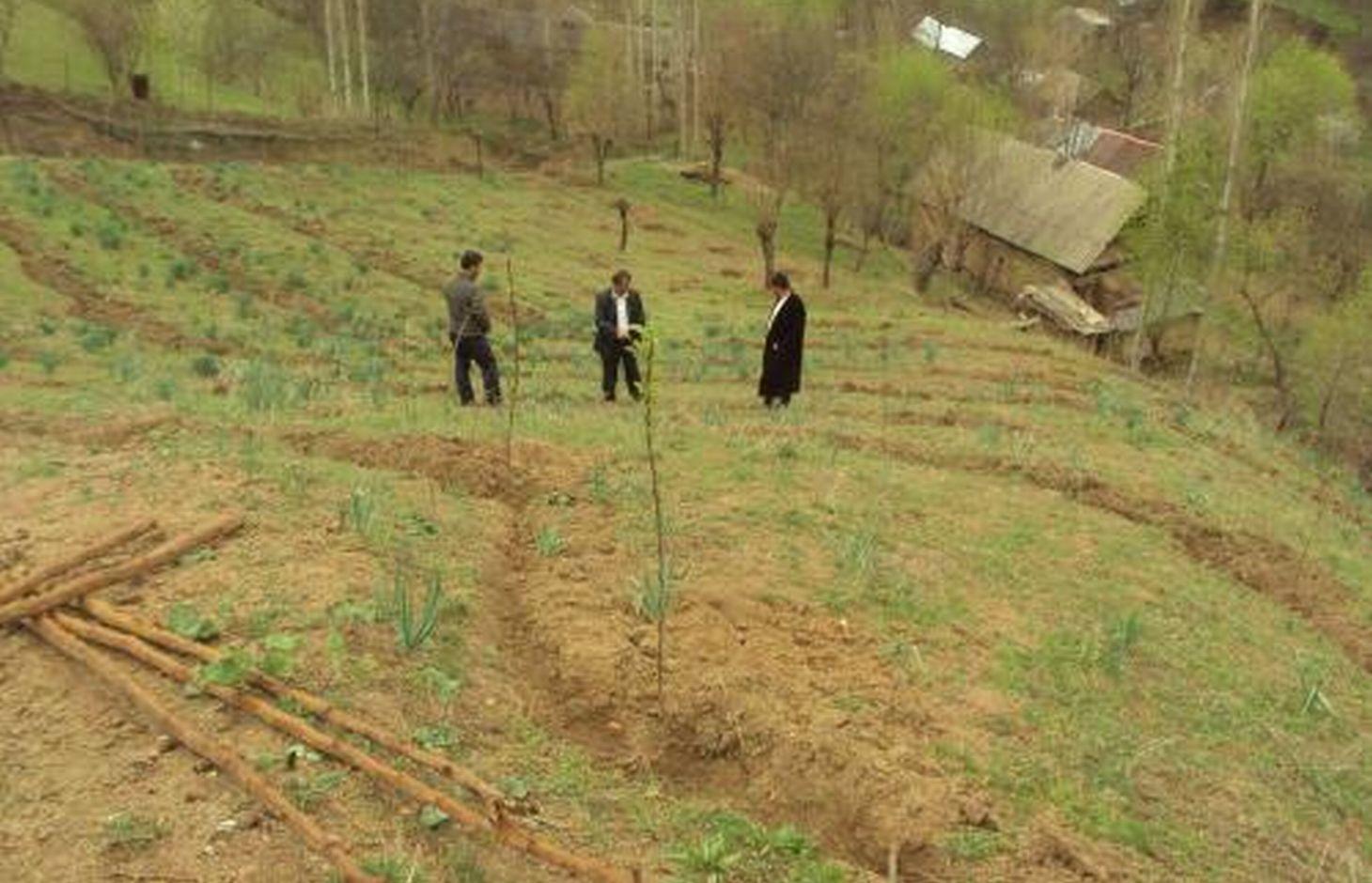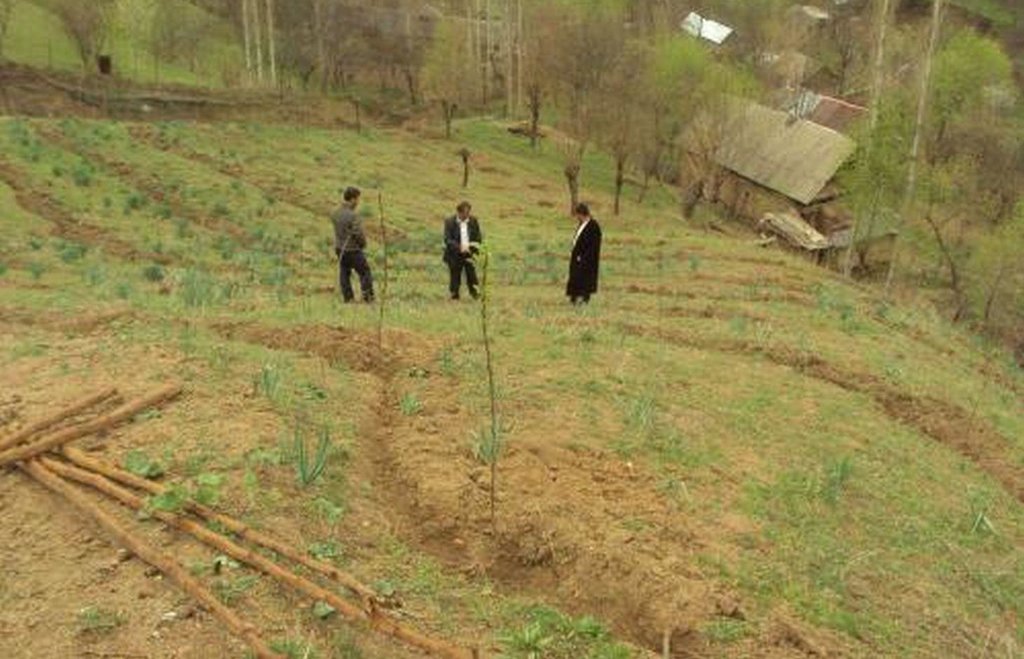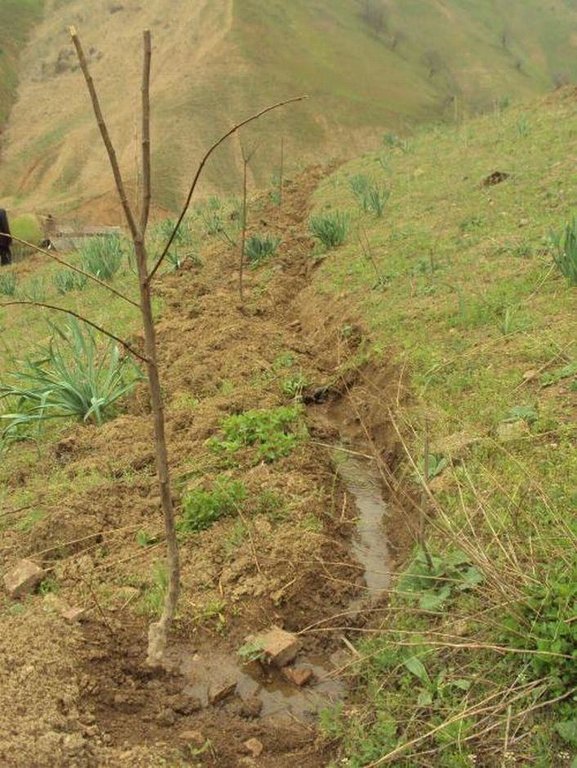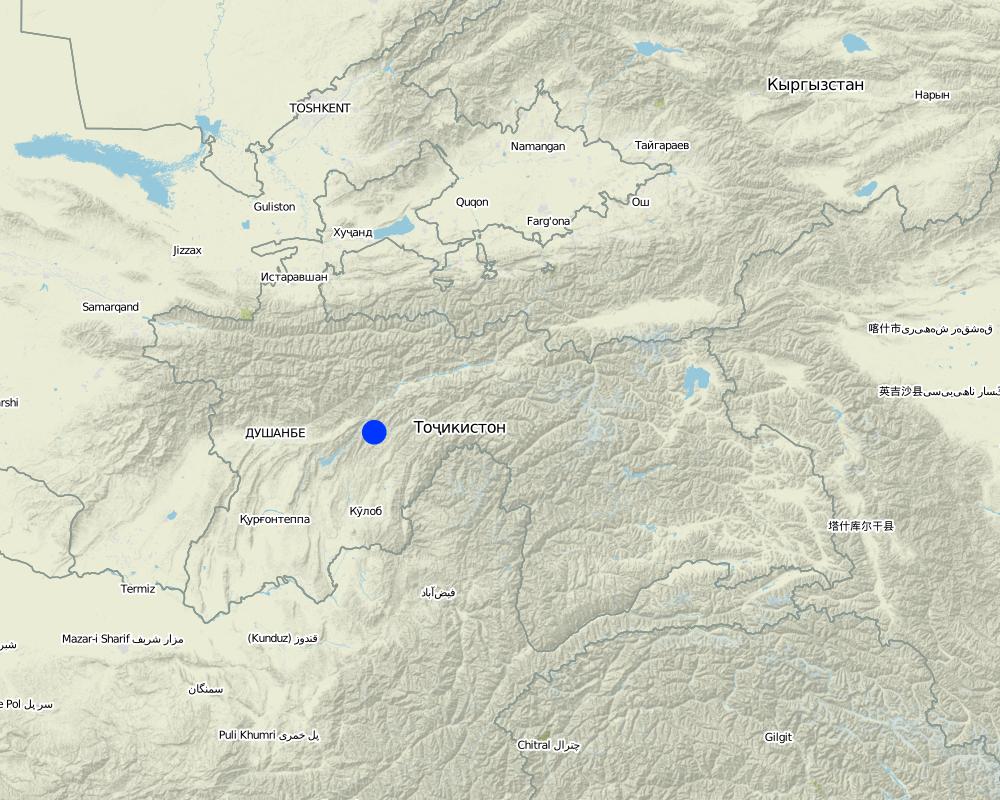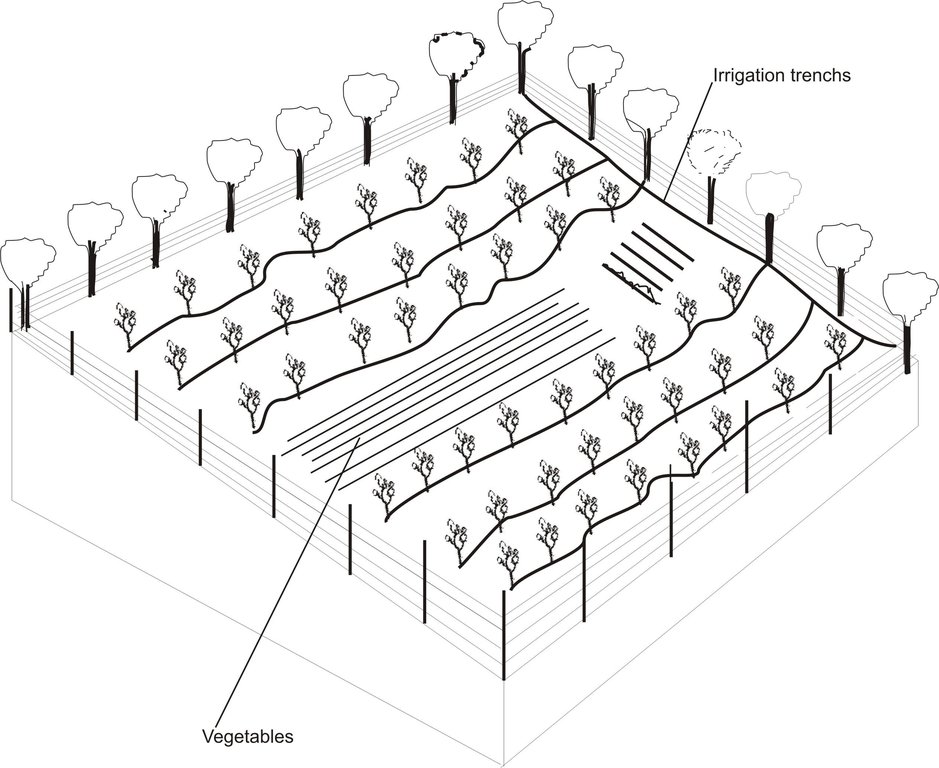Planting of fruit trees to increase slope stabilisation [Tayikistán]
- Creación:
- Actualización:
- Compilador: Gulniso Nekushoeva
- Editor: –
- Revisores: David Streiff, Alexandra Gavilano
Табдил додани чарохгох ба бог
technologies_1520 - Tayikistán
- Resumen completo en PDF
- Resumen completo en PDF para imprimir
- Resumen completo en el navegador
- Resumen completo (sin formato)
- Planting of fruit trees to increase slope stabilisation: 20 de agosto de 2019 (inactive)
- Planting of fruit trees to increase slope stabilisation: 2 de noviembre de 2021 (public)
- Planting of fruit trees to increase slope stabilisation: 20 de julio de 2017 (inactive)
- Planting of fruit trees to increase slope stabilisation: 22 de julio de 2017 (inactive)
- Planting of fruit trees to increase slope stabilisation: 15 de marzo de 2017 (inactive)
Visualizar secciones
Expandir todo Colapsar todos1. Información general
1.2 Detalles de contacto de las personas de referencia e instituciones involucradas en la evaluación y la documentación de la Tecnología
Especialista MST:
Especialista MST:
Nombre de la(s) institución(es) que facilitaron la documentación/ evaluación de la Tecnología (si fuera relevante)
NCCR North-South (NCCR North-South) - KirguistánNombre de la(s) institución(es) que facilitaron la documentación/ evaluación de la Tecnología (si fuera relevante)
Tajik Academy of Agricultural Sciences (Tajik Academy of Agricultural Sciences) - TayikistánNombre de la(s) institución(es) que facilitaron la documentación/ evaluación de la Tecnología (si fuera relevante)
Tajik Soil Insitute (Tajik Soil Institute) - TayikistánNombre de la(s) institución(es) que facilitaron la documentación/ evaluación de la Tecnología (si fuera relevante)
CAMP - Central Asian Mountain Partnership (CAMP - Central Asian Mountain Partnership) - Kirguistán1.3 Condiciones referidas al uso de datos documentados mediante WOCAT
¿Cuándo se compilaron los datos (en el campo)?
16/03/2011
El compilador y la/s persona(s) de referencia claves aceptan las condiciones acerca del uso de los datos documentados mediante WOCAT:
Sí
2. Descripción de la Tecnología MST
2.1 Breve descripción de la Tecnología
Definición de la Tecnología:
Planting fruit tree orchards to increase the stability of the steep loess soil slopes.
2.2 Descripción detallada de la Tecnología
Descripción:
This technology involved the planting of several varieties of native fruit trees to help stabilise steep loess mountain slopes. Seven species of fruit trees were planted in seven different locations, in two watersheds within the district of Nurobod in Tajikistan. The locations were chosen as a result of a natural disaster workshop that identified the areas most susceptible to landslides.
In consultation with the Institute of Horticulture a fruit tree planting scheme was devised and using project money the identified area was enclosed with a wire perimeter fence. The fruit trees were planted along irrigation contours running at shallow angles parallel to the slope.
Purpose of the Technology: The best locations for planting the fruit trees were decided on via a participatory community workshop on natural disaster risk management.
During the workshop the community identified areas around the village that were considered high risk. A fruit tree planting scheme was implemented in these areas to help stabilise the slopes, reduce surface water run off and top soil erosion, and reduce the risk of landslides. As the trees grew they were intercropped with wheat and espercet.
Establishment / maintenance activities and inputs: Several 'at risk' areas were identifed within these workshops, therefore the project team had to assess the areas for suitability. Two of the main criteria used included the access to water and if there was sufficient depth of top soil to sustain a fruit orchard.
Once the area was decided upon, a Memorandum of Understanding (MoU) was signed with the particular land user. It was made clear to the community that the land was chosen based upon the decisions from the workshop and not because of any form of favouritism towards the land user. The MoU stated that the land user was responsible for the planting and maintenance of the orchards.
The Horticultural Institute devised a planting a scheme based upon the loaction and soil type. The implementation activities occurred in early spring. A continuos wire fence was erected around the area, and the fruit trees were planted at five metre intervals along a dug contour irrigation ditch. One kilo of organic fertiliser was applied to each tree and later in the season they were sprayed with pesticides.
Natural / human environment: Nurobod district is a mountainous area, with large tributaries flowing into the Vasht river. There are mass erosion processes at work, causing gullies and washing away the top soil. The previous civil war, compounded by harsh winters resulted in extensive clearance of the surrounding vegetation for fuel. These areas have became further degraded by over grazing on the remaining grass lands.
The local population suffers from high levels of labour migration of young men to Russia and resulting in a drain of knowledge and able bodied workers. This leaves the remaining families particulary vulnerable in this specific climate.
2.3 Fotografías de la Tecnología
2.5 País/ región/ lugares donde la Tecnología fue aplicada y que se hallan comprendidos por esta evaluación
País:
Tayikistán
Región/ Estado/ Provincia:
Tajikistan
Especifique más el lugar :
Nurobod
Map
×2.6 Fecha de la implementación
Si no se conoce el año preciso, indique la fecha aproximada:
- hace menos de 10 años (recientemente)
2.7 Introducción de la Tecnología
Especifique cómo se introdujo la Tecnología:
- mediante proyectos/ intervenciones externas
Comentarios (tipo de proyecto, etc.):
The project was implemented in 2010.
3. Clasificación de la Tecnología MST
3.1 Propósito(s) principal(es) de la Tecnología MST
- reducir, prevenir, restaurar la degradación de la tierra
- reducir el riesgo de desastres naturales
3.2 Tipo(s) actuales de uso de la tierra donde se aplica la Tecnología

Tierra de pastoreo
Tierras de pastoreo extensivo:
- Ganadería de hacienda
Especies y productos animales principales:
cows, sheep and goats
Comentarios:
Major land use problems (compiler’s opinion): The steep loess slopes are devoid of vegetation, therefore the land is prone to washing away of top soil, gulley formation, and potential landslides.
Major land use problems (land users’ perception): The land has become unuseable, it was used as pasture land but every year it seems to be getting worse.
Ranching: cows, sheep and goats
Future (final) land use (after implementation of SLM Technology): Forests / woodlands: Fp: Plantations, afforestations
Si el uso de la tierra ha cambiado debido a la implementación de la Tecnología, indique el uso de la tierra antes de la implementación de la Tecnología.
Grazing land: Ge: Extensive grazing land
3.3 Información adicional sobre el uso de tierras
Provisión de agua para la tierra donde se aplica la Tecnología:
- mixta de secano – irrigada
Número de temporadas de cultivo por año:
- 1
Especifique:
Longest growing period in days: 200Longest growing period from month to month: March - October
Densidad del ganado (si fuese relevante):
1-10 LU /km2
3.4 Grupo MST al que pertenece la Tecnología
- medida de pendiente transversal
3.5 Difusión de la Tecnología
Especifique la difusión de la Tecnología:
- distribuida parejamente sobre un área
Si la tecnología se halla difundida homogéneamente en un área, indique el área aproximada que cubre:
- < 0.1 km2 (10 ha)
Comentarios:
Total area covered by the SLM Technology is 0.1 m2.
The SLM technology was implemented in 7 different locations covering 5 villages within the Mujiharf and Hakimi jamoats of Nurobod District. The two main watersheds are shown in the googleEarth file. The plot sizes varied between 0.5 - 1 H.a.
3.6 Medidas MST que componen la Tecnología

medidas vegetativas
- V1: Cubierta de árboles y arbustos
Comentarios:
Main measures: vegetative measures
Type of vegetative measures: aligned: -contour
3.7 Principales tipos de degradación de la tierra encarados con la Tecnología

erosión de suelos por agua
- Wt: pérdida de capa arable/ erosión de la superficie
- Wg: erosión en cárcavas
- Wm: movimiento de masas / deslizamientos de tierra

degradación biológica
- Bc: reducción de la cobertura vegetal del suelo
Comentarios:
Main type of degradation addressed: Wt: loss of topsoil / surface erosion, Wg: gully erosion / gullying, Wm: mass movements / landslides
Secondary types of degradation addressed: Bc: reduction of vegetation cover
Main causes of degradation: deforestation / removal of natural vegetation (incl. forest fires) (Any shrubs and bushes previously on the land were removed.), over-exploitation of vegetation for domestic use (Shrubs and bushes were removed as fodder and for fuel purposes.), war and conflicts (Natural resources became increasingly valuable during the civil war of the 1990's.)
Secondary causes of degradation: overgrazing (Once the bushes were removed the area was used for grazing.), Heavy / extreme rainfall (intensity/amounts) (Heavy rainfall events have contributed to the degradation of the land.)
3.8 Prevención, reducción o restauración de la degradación de la tierra
Especifique la meta de la Tecnología con relación a la degradación de la tierra:
- reducir la degradación de la tierra
- restaurar/ rehabilitar tierra severamente degradada
Comentarios:
Secondary goals: prevention of land degradation
4. Especificaciones técnicas, actividades de implementación, insumos y costos
4.1 Dibujo técnico de la Tecnología
4.2 Especificaciones técnicas/ explicaciones del dibujo técnico
The drawing shows a perimeter fence enclosing terraces of fruit trees. The trees are irrigated through a contour trench running at a shallow angle perpendicular to the slope. The land users have taken the opportunity to optimise the cultivated land by planting perennial and wheat crops between the rows of trees.
Location: Mujiharf. Nurobod, tajikisatn
Date: 22nd June 2011
Technical knowledge required for field staff / advisors: low (The technology is relatively straight forward and easy to implement.)
Technical knowledge required for land users: low (The land user is responsible for the continued maintenance of the fruit trees.)
Main technical functions: improvement of ground cover
Secondary technical functions: control of dispersed runoff: retain / trap, control of dispersed runoff: impede / retard, spatial arrangement and diversification of land use
Aligned: -contour
Vegetative material: F : fruit trees / shrubs
Number of plants per (ha): 400
Vertical interval between rows / strips / blocks (m): 5
Spacing between rows / strips / blocks (m): 5
Vertical interval within rows / strips / blocks (m): 5
Width within rows / strips / blocks (m): 5
Fruit trees / shrubs species: Cherry, Apple, Quince, Pear, Plum, Peach, Walnut
Slope (which determines the spacing indicated above): 25.00%
Gradient along the rows / strips: 2.00%
4.3 Información general sobre el cálculo de insumos y costos
otra / moneda nacional (especifique):
somoni
Indique la tasa de cambio de USD a la moneda local (si fuese relevante): 1 USD =:
4,5
Indique el costo promedio del salario de trabajo contratado por día:
25.00
4.4 Actividades de establecimiento
| Actividad | Tipo de medida | Momento | |
|---|---|---|---|
| 1. | Erection of Fence | Vegetativas | Spring - end of march |
| 2. | Planting of fruit trees. | Vegetativas | March / April |
4.5 Costos e insumos necesarios para el establecimiento
| Especifique insumo | Unidad | Cantidad | Costos por unidad | Costos totales por insumo | % de los costos cubiertos por los usuarios de las tierras | |
|---|---|---|---|---|---|---|
| Mano de obra | Building fence | Persons/day | 28,0 | 25,0 | 700,0 | 100,0 |
| Mano de obra | Planting fruit trees | Persons/day | 40,0 | 25,0 | 1000,0 | 100,0 |
| Equipo | Tools | Pieces | 6,0 | 20,0 | 120,0 | |
| Material para plantas | Seedlimgs | pieces | 400,0 | 8,0 | 3200,0 | |
| Fertilizantes y biocidas | Compost/manure | tons | 1,0 | 225,0 | 225,0 | 100,0 |
| Fertilizantes y biocidas | 1,0 | |||||
| Material de construcción | Metal fence and posts | meter | 400,0 | 12,0 | 4800,0 | |
| Costos totales para establecer la Tecnología | 10045,0 | |||||
Si el usuario de la tierra no cubrió el 100% de los costos, indique quién financió el resto del costo:
Horticulture Institue
Comentarios:
Duration of establishment phase: 2 month(s)
Costs are per h.a.
4.6 Actividades de establecimiento/ recurrentes
| Actividad | Tipo de medida | Momento/ frequencia | |
|---|---|---|---|
| 1. | pruning and tree care | Vegetativas | Annually |
4.7 Costos e insumos necesarios para actividades de mantenimiento/ recurrentes (por año)
| Especifique insumo | Unidad | Cantidad | Costos por unidad | Costos totales por insumo | % de los costos cubiertos por los usuarios de las tierras | |
|---|---|---|---|---|---|---|
| Mano de obra | Prunning and tree care | Persons/day | 15,0 | 16,6666667 | 250,0 | 100,0 |
| Indique los costos totales para mantenecer la Tecnología | 250,0 | |||||
Comentarios:
Machinery/ tools: spades, picks
The costs were calculated at 2010 prices for 400 trees planted over 1 h.a.
4.8 Factores más determinantes que afectan los costos:
Describa los factores más determinantes que afectan los costos:
The main issue was the procurement of the fruit trees from a reliable credible source. Since the start of the project, land users purchased trees from local tree nurseries but the trees were of poor quality and some already had signs of disease. The scarity of natural resources, and the lack of controlled grazing means that wire fencing had to be used, This could only be purchased outside of the district and thus incurred high transport costs.
5. Entorno natural y humano
5.1 Clima
Lluvia anual
- < 250 mm
- 251-500 mm
- 501-750 mm
- 751-1,000 mm
- 1,001-1,500 mm
- 1,501-2,000 mm
- 2,001-3,000 mm
- 3,001-4,000 mm
- > 4,000 mm
Zona agroclimática
- semi-árida
Thermal climate class: temperate
5.2 Topografía
Pendientes en promedio:
- plana (0-2 %)
- ligera (3-5%)
- moderada (6-10%)
- ondulada (11-15%)
- accidentada (16-30%)
- empinada (31-60%)
- muy empinada (>60%)
Formaciones telúricas:
- meseta/ planicies
- cordilleras
- laderas montañosas
- laderas de cerro
- pies de monte
- fondo del valle
Zona altitudinal:
- 0-100 m s.n.m.
- 101-500 m s.n.m.
- 501-1,000 m s.n.m
- 1,001-1,500 m s.n.m
- 1,501-2,000 m s.n.m
- 2,001-2,500 m s.n.m
- 2,501-3,000 m s.n.m
- 3,001-4,000 m s.n.m
- > 4,000 m s.n.m
Comentarios y especificaciones adicionales sobre topografía :
Altitudinal zone: For the seven plots.
5.3 Suelos
Profundidad promedio del suelo:
- muy superficial (0-20 cm)
- superficial (21-50 cm)
- moderadamente profunda (51-80 cm)
- profunda (81-120 cm)
- muy profunda (>120 cm)
Textura del suelo (capa arable):
- mediana (limosa)
Materia orgánica de capa arable:
- media (1-3%)
Si se halla disponible, adjunte una descripción completa de los suelos o especifique la información disponible, por ej., tipo de suelo, pH/ acidez de suelo, capacidad de intercambio catiónico, nitrógeno, salinidad, etc. :
Soil texture (topsoil): Silt
Soil fertility is medium
Soil drainage / infiltration is medium
Soil water storage capacity is high
5.4 Disponibilidad y calidad de agua
Agua subterránea:
5-50 m
Calidad de agua (sin tratar):
agua potable de buena calidad
5.5 Biodiversidad
Diversidad de especies:
- baja
5.6 Las características de los usuarios de la tierra que aplican la Tecnología
Orientación del mercado del sistema de producción:
- subsistencia (autoprovisionamiento)
Ingresos no agrarios:
- > 50% de todo el ingreso
Nivel relativo de riqueza:
- muy pobre
- pobre
Individuos o grupos:
- individual/ doméstico
Género:
- mujeres
- hombres
Indique otras características relevantes de los usuarios de las tierras:
Land users applying the Technology are mainly common / average land users
Difference in the involvement of women and men: The men were involved with the initial planting of the trees. However the women complete most of the ongoing care and maintenance of the fruit trees,
Population density: 10-50 persons/km2
Annual population growth: 2% - 3%
10% of the land users are average wealthy and own 70% of the land.
45% of the land users are poor and own 15% of the land.
45% of the land users are poor and own 15% of the land.
Off-farm income specification: Most households in this district recieve remittances from abroad.
Market orientation of production system subsistence (self-supply): Low grade pasture land
5.7 Área promedio de la tierra que pertenece a o es arrendada por usuarios de tierra que aplican la Tecnología
- < 0.5 ha
- 0.5-1 ha
- 1-2 ha
- 2-5 ha
- 5-15 ha
- 15-50 ha
- 50-100 ha
- 100-500 ha
- 500-1,000 ha
- 1,000-10,000 ha
- > 10,000 ha
¿Esto se considera de pequeña, mediana o gran escala (refiriéndose al contexto local)?
- pequeña escala
Comentarios:
most households in the region have 0.5h.a
5.8 Tenencia de tierra, uso de tierra y derechos de uso de agua
Tenencia de tierra:
- estado
- individual, sin título
Derechos de uso de tierra:
- comunitarios (organizado)
Comentarios:
All land in Tajikistan is owned by the state, user rights are defined here by the local government.
5.9 Acceso a servicios e infraestructura
salud:
- pobre
- moderado
- bueno
educación:
- pobre
- moderado
- bueno
asistencia técnica:
- pobre
- moderado
- bueno
empleo (ej. fuera de la granja):
- pobre
- moderado
- bueno
mercados:
- pobre
- moderado
- bueno
energía:
- pobre
- moderado
- bueno
caminos y transporte:
- pobre
- moderado
- bueno
agua potable y saneamiento:
- pobre
- moderado
- bueno
servicios financieros:
- pobre
- moderado
- bueno
6. Impactos y comentarios para concluir
6.1 Impactos in situ demostrados por la Tecnología
Impactos socioeconómicos
Producción
producción de madera
Comentarios/ especifique:
400 trees planted
diversidad de producto
Comentarios/ especifique:
new products to sell
Ingreso y costos
ingreso agrario
Comentarios/ especifique:
seven varieties of fruits
diversidad de fuentes de ingreso
Comentarios/ especifique:
new source of sustainable income
Otros impactos socioeconómicos
New skills in fruit tree cultivation
Comentarios/ especifique:
The implementation of the technology is supported with training.
Impactos socioculturales
seguridad alimentaria/ autosuficiencia
Comentarios/ especifique:
increased fruit production
situación de salud
MST/ conocimiento de la degradación de la tierra
Community knowledge of fruit tree cultivation
Comentarios/ especifique:
training provided
Livelihood and human well-being
Comentarios/ especifique:
Training on fruit tree cultivation was provided for the community in conjunction with the implementation of the planting of the trees, to help improve the fruit yields in the community and the health of the trees.
Impactos ecológicos
Ciclo de agua/ escurrimiento de sedimento
escurrimiento superficial
Comentarios/ especifique:
trees absorb the water
Suelo
ciclo/ recarga de nutrientes
Comentarios/ especifique:
regeneration of the biomass cycle
Biodiversidad: vegetación, animales
especies benéficas
Comentarios/ especifique:
introduced new species to the area.
Reducción de riesgos de desastres y riesgos climáticos
deslizamientos/ fluyos de escombros
Comentarios/ especifique:
main goal of the SLM technology
6.3 Exposición y sensibilidad de la Tecnología al cambio climático gradual y a extremos relacionados al clima/ desastres (desde la percepción de los usuarios de tierras)
Cambio climático gradual
Cambio climático gradual
| Estación | tipo de cambios climáticos/ climas extremos | ¿Cómo es que la tecnología soporta esto? | |
|---|---|---|---|
| temperatura anual | incrementó | no muy bien |
Extremos (desastres) relacionados al clima
Desastres climatológicos:
| ¿Cómo es que la tecnología soporta esto? | |
|---|---|
| tormenta de lluvia local | no muy bien |
Desastres climatológicos
| ¿Cómo es que la tecnología soporta esto? | |
|---|---|
| sequía | no muy bien |
Otras consecuencias relacionadas al clima
Otras consecuencias relacionadas al clima
| ¿Cómo es que la tecnología soporta esto? | |
|---|---|
| increase in pests | no muy bien |
Comentarios:
The technology initially used 7 species of trees. However after a while it became apparent that the peach trees were more sensitive to heavy rainfall which occured especially in the spring, and therefore when the orchards were expanded peach trees were not planted again. Land owners have also planted espercet and wheat between the trees to help further stabilise the slopes.
6.4 Análisis costo-beneficio
¿Cómo se comparan los beneficios con los costos de establecimiento (desde la perspectiva de los usuarios de tierra)?
Ingresos a corto plazo:
ligeramente negativo
Ingresos a largo plazo:
positivo
¿Cómo se comparan los beneficios con los costos de mantenimiento/ recurrentes (desde la perspectiva de los usuarios de tierra)?
Ingresos a corto plazo:
negativo
Ingresos a largo plazo:
ligeramente positivo
Comentarios:
It can take 3-12 years before the fruits can be harvested, depending upon the variety. The trees will require more care and attention in the first few years to ensure their long term survival.
6.5 Adopción de la Tecnología
- 1-10%
Si tiene la información disponible, cuantifique (número de hogares y/o área cubierta):
7 households in an area of 10 ha
De todos quienes adoptaron la Tecnología, ¿cuántos lo hicieron espontáneamente, es decir, sin recibir incentivos/ pagos materiales?
- 0-10%
Comentarios:
100% of land user families have adopted the Technology with external material support
7 land user families have adopted the Technology with external material support
Comments on acceptance with external material support: All seven families implemented the technology.
There is no trend towards spontaneous adoption of the Technology
Comments on adoption trend: Nothing has been physically monitored but there was lively discussion in the communuty about expanding the planting areas.
6.7 Fuerzas/ ventajas/ oportunidades de la Tecnología
| Fuerzas/ ventajas/ oportunidades desde la perspectiva del usuario de la tierra |
|---|
| It has made efficient use of the land that was previously used for grazing of livestock. |
| I have planted espercet in within the fence line, to improve my fodder production. |
|
I learnt how to care for the trees in the training provided. How can they be sustained / enhanced? Further ongoing professional support for the land user would be beneficial. |
| Fuerzas/ ventajas/ oportunidades desde la perspectiva del compilador o de otra persona de referencia clave |
|---|
|
It helped stabilise the soil and reduce the risk of mudslides. How can they be sustained / enhanced? Other identified areas could be planted with trees. |
|
It helped to reduce the rates of surface water top soil erosion. How can they be sustained / enhanced? The area of land could be extended. |
|
The fencing helped protect the technology from grazing livestock. How can they be sustained / enhanced? The fruit trees within the fence can be intercropped with perennial grasses or other crops. |
| It provides long term food and potential income for the land user. |
6.8 Debilidades/ desventajas/ riesgos de la Tecnología y formas de sobreponerse a ellos
| Debilidades/ desventajas/ riesgos desde la perspectiva del usuario de la tierra | ¿Cómo sobreponerse a ellas? |
|---|---|
| There are tree diseases in the district, which may spread to the fruit trees and many locals cannot afford the pesticides required to help prevent these. | Pesticides could be provided by larger farms or cooperatives could be set up. |
| The livestock broke through the fence and ate some of the saplings. | In some instances double fencing may be requried. |
| Debilidades/ desventajas/ riesgos desde la perspectiva del compilador o de otra persona de referencia clave | ¿Cómo sobreponerse a ellas? |
|---|---|
| The areas identified to be stabilised do not always have access to water and therefore the technology is limited. | Piped irrigation and drip irrigation techniques could be applied. |
| The land owner does not have any returns on the intial investment for a minimum of three years. Also they will have to pay tax on the land after three years. Some trees will not produce fruits for up to 12yrs. | Loans or subsidies could be provided to the land user over this initial period of time. |
Vínculos y módulos
Expandir todo Colapsar todosVínculos
No hay vínculos
Módulos
No se hallaron módulos


